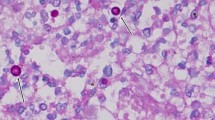Abstract
In recent years, the frequency of infections due to saprophytic fungi has increased. Cryptococcus laurentii, recently classified as Papiliotrema laurentii, is responsible for fungemia, meningitis, and superficial infections. Here, we report the first case of cutaneous Papiliotrema (Cryptococcus) laurentii infection in a 23-year-old Caucasian woman affected by an autoimmune thyroiditis with hypothyroidism. Impairments of the immune system are often associated with unusual fungal infections, which cannot be neglected. The isolate strain was susceptible to Amphotericin B while resistant to fluconazole, itraconazole, voriconazole, and terbinafine. The patient was successfully treated with Amphotericin B.


Similar content being viewed by others
References
Ajesh K, Sreejith K (2012) Cryptococcus laurentii biofilms: structure, development and antifungal drug resistance. Mycopathologia 174(5–6):409–419
Liu XZ, Wang QM, Göker M et al (2015) Towards an integrated phylogenetic classification of the Tremellomycetes. Stud Mycol 81:85–147
Banerjee P, Haider M, Trehan V et al (2013) Cryptococcus laurentii fungemia. Indian J Med Microbiol 31(1):75–77
Shankar EM, Kumarasamy N, Bella D et al (2006) Pneumonia and pleural effusion due to Cryptococcus laurentii in a clinically proven case of AIDS. Can Respir J 13(5):275–278
Furman-Kuklińska K, Naumnik B, Myśliwiec M (2009) Fungaemia due to Cryptococcus laurentii as a complication of immunosuppressive therapy--a case report. Adv Med Sci 54(1):116–119
Castro-Lainez MT, Deliz-Aguirre R, Antunez D et al (2019) Cryptococcus laurentii meningitis in a non-HIV patient. IDCases 8:e00612
Lause M, Kamboj A, Fernandez Faith E (2017) Dermatologic manifestations of endocrine disorders. Transl Pediatr 6(4):300–312
Myhre AG, Stray-Pedersen A, Spangen S et al (2004) Chronic mucocutaneous candidiasis and primary hypothyroidism in two families. Eur J Pediatr 63(10):604–611
Macura AB, Gasińska T, Pawlik B (2005) Nail susceptibility to fungal infections in patients with hypothyroidism and hyperthyroidism. Przegl Lek 62(4):218–221
Reszke R, Pełka D, Walasek A, Machaj Z, Reich A (2015) Skin disorders in elderly subjects. Int J Dermatol 54(9):e332–e338
Khosravi AR, Mansouri P, Saffarian Z, Vahedi G, Nikaein D (2018) Chronic mucocutaneous candidiasis, a case study and literature review. J Mycol Med 28(1):206–210
Gupta M, Mishra AK, Singh SK (2018) Cryptococcus laurentii fungemia in a low birth weight preterm neonate: India. J Infect Public Health 11(6):896–897
Eslami N, Tavakol M, Mesdaghi M et al (2017) A gain-of-function mutation of STAT1: a novel genetic factor contributing to chronic mucocutaneous candidiasis. Acta Microbiol CI Immunol Hung 64(2):191–201
Acknowledgments
We gratefully acknowledge personnel of Hospital of Desio for technical support. We also thank Dr. Elena Intra for reviewing the manuscript.
Author information
Authors and Affiliations
Corresponding author
Ethics declarations
Conflict of interest
The authors declare that they have no conflict of interest.
Informed consent
Informed consent to publish was obtained from the individual included in the study.
Additional information
Publisher’s note
Springer Nature remains neutral with regard to jurisdictional claims in published maps and institutional affiliations.
Rights and permissions
About this article
Cite this article
Intra, J., Sarto, C. & Brambilla, P. A rare case of cutaneous Papiliotrema (Cryptococcus) laurentii infection in a 23-year-old Caucasian woman affected by an autoimmune thyroid disorder with hypothyroidism. Eur J Clin Microbiol Infect Dis 40, 647–650 (2021). https://doi.org/10.1007/s10096-020-04058-5
Received:
Accepted:
Published:
Issue Date:
DOI: https://doi.org/10.1007/s10096-020-04058-5




